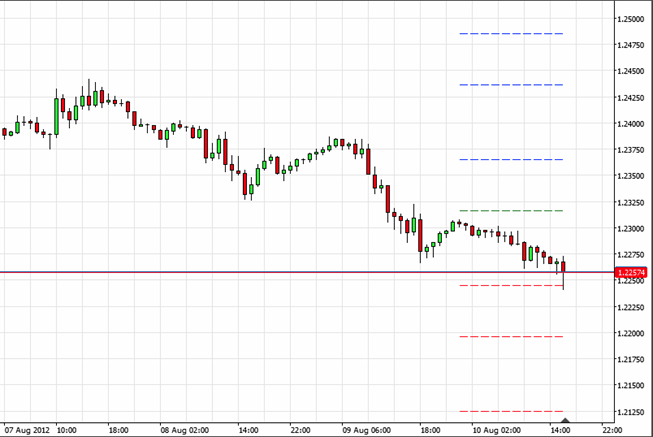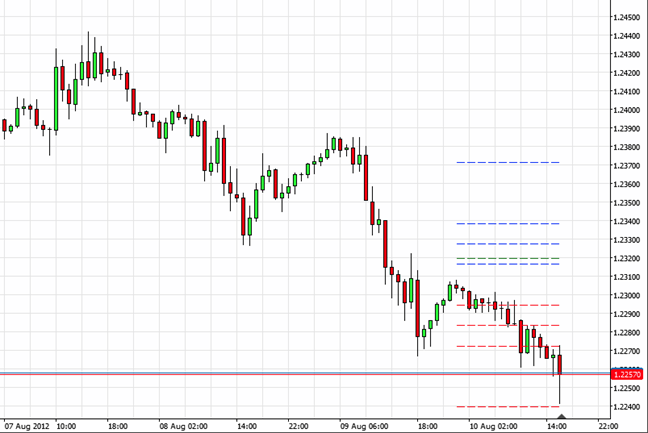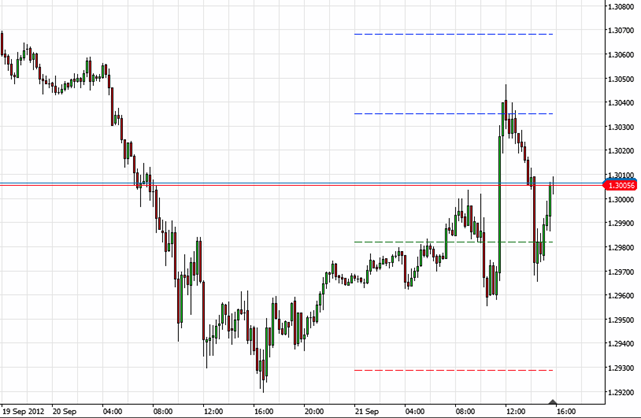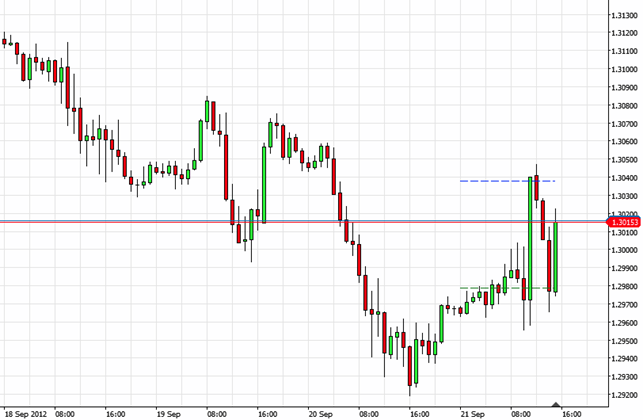Thành viên V&S Group
There are 4 ways to calculate pivot points:
R2 = PP + High – Low
R1 = (2 X PP) – Low
PP = (H + L + 2C) / 4
S1 = (2 X PP) – High
S2 = PP – High + Low
C – Closing Price, H – High, L – Low
As you may have noticed the Woodies Pivot calculation is quite different than the standard pivot points formula. One of the primary differences is that the Woodie’s formula puts more weight on the closing price. Notice that the Pivot Point (PP) calculation involves multiplying the closing price by 2, and then adding the High and Low. From this you would divide by 4 to get the PP level. This might sound a bit confusing at first, but essentially it works similar to an Exponential Moving Average, where the latter data is weighted more heavily than the earlier data. Also as a side note, you will often find in the FX market that the opening price is the same as the closing price. This is due to the fact that FX markets trade 24 hours a day.

Because they have different formulas, levels obtained through the Woodie calculations are very different from those gotten through the standard method. Some traders prefer to use the Woodie formulas because they give more weight to the closing price of the previous period.
Camarilla Pivot Points were invented by Nick Scott in the late 1980’s. They are similar in concept to Woodie’s in that they use the prior day’s closing price and range to compute the levels. But instead of 2 Resistance levels, and 2 Support levels, the Camarilla equation calls for 4 resistance levels and 4 support levels. Add to that the Pivot Point level, and there are a total of 9 levels plotted for Camarilla. Also, an interesting part of the Camarilla equation is that a special multiplier is included in the formula.
R4 = C + ((H-L) x 1.5000)
R3 = C + ((H-L) x 1.2500)
R2 = C + ((H-L) x 1.1666)
R1 = C + ((H-L) x 1.0833)
PP = (H + L + C) / 3
S1 = C – ((H-L) x 1.0833)
S2 = C – ((H-L) x 1.1666)
S3 = C – ((H-L) x 1.2500)
S4 = C – ((H-L) x 1.5000)
C – Closing Price, H – High, L – Low
As you can see, we have a total of 4 Resistance levels, and a total of 4 Support Levels. Many intraday traders utilize the Camarilla levels to fade price moves when then reach the R3 or S3 level. The idea is that the markets are cyclical in nature, and that a strong price move from the prior session, should tend to revert back within its value range the following day. Stops could be placed at the R4 or S4 levels. If, however, price action continues beyond the R4 or S4 level, then a stop and reverse can be initiated in anticipation for a strong trend day and continued price move beyond the R4 or S4 level.

Because of this, it’s possible that resistance levels could be below the pivot point or support levels could be above it.
Fibonacci studies such as retracements, extensions, and projections are quite popular in the Forex market. The primary Fibonacci levels that traders watch most closely are the 38.2% and 61.8% retracement levels. But did you know that you could incorporate these Fibonacci levels into a Pivot Point calculation as well? In fact, it is very similar to the Standard pivot points, with the additional inclusion of the 38.2% and 61.8% and 100% ratios.
R3 = PP + ((High – Low) x 1.000)
R2 = PP + ((High – Low) x .618)
R1 = PP + ((High – Low) x .382)
PP = (H + L + C) / 3
S1 = PP – ((High – Low) x .382)
S2 = PP – ((High – Low) x .618)
S3 = PP – ((High – Low) x 1.000)
C – Closing Price, H – High, L – Low
Fibonacci pivot point levels are determined by first calculating the pivot point like you would the standard method. Next, multiply the previous day’s range with its corresponding Fibonacci level. Most traders use the 38.2%, 61.8% and 100% retracements in their calculations. Finally, add or subtract the figures you get to the pivot point and you’ve got your Fibonacci pivot point levels!

The logic behind this is that many traders like using the Fibonacci ratios. People use it for retracement levels, moving averages, etc.
Demark Pivot points were introduced by Tom Demark, a famous technical analyst and trader. Demark Pivots are very different from other types of Pivot Points that we have discussed thus far. These pivot points have a conditional nature based on the relationship between the opening price and the closing price. Demark uses the number X to compute the upper resistance level and the lower support line.
Here is how you calculate Demark Pivot Points:
If C > O, then X = (2 x H) + L + C
If C < O, then X = H + (2 x L) + C
If C = O, then X = H + L + (2 x C)
PP = X/4
R1 = X/2 – Low
S1 = X/2 – High
C – Closing Price, O – Opening Price, H – High, L – Low
Demark Pivot Points place more emphasis on the recent price action. Many Demark traders use. Demark Pivot Points in conjunction with TD lines to find intraday support and resistance levels in the market. TD lines are much more objective than traditional trend lines. They are drawn from left to right based on the demand points in an uptrend and supply points in a downtrend. The objective is to find points along the TD line that are most likely prone to a breakout move.

*The information presented above is intended for informative and educational purposes, should not be considered as investment advice, or an offer or solicitation for a transaction in any financial instrument and thus should not be treated as such. Past performance is not a reliable indicator of future results.

Hội chợ đầu tư Cairo 2021
Giải thưởng Siêu FinTech 2022
Fintech Châu Âu 2022
Giải thưởng Forex toàn cầu năm 2023
Hội chợ đầu tư Cairo 2021
Giải thưởng Siêu FinTech 2022
Fintech Châu Âu 2022
Giải thưởng Forex toàn cầu năm 2023
Bản quyền © 2024 - Đã đăng ký bản quyền.
Soho Markets LLC được thành lập tại St. Vincent & Grenadines với giấy phép số 1310 LLC 2021, cung cấp dịch vụ Giao dịch Toàn cầu.
Cảnh báo Rủi ro: CFD là công cụ giao dịch phức tạp và có nguy cơ mất tiền nhanh chóng do đòn bẩy. Bạn nên xem xét liệu bạn có hiểu cách thức hoạt động của thị trường CFD hay chưa và liệu bạn có khả năng chấp nhận rủi ro thua lỗ. Vui lòng đọc toàn bộ Cảnh báo Rủi ro.
Khu vực hạn chế: SOHO MARKETS GLOBAL LIMITED không cung cấp dịch vụ tại lãnh thổ trực thuộc Hoa Kỳ, Canada, Israel, Nhật, Triều Tiên, Bỉ và khu vực bị UN/EU trừng phạt.
Soho Markets Global Limited và Soho Markets LLC không cung cấp dịch vụ cho khách hàng khu vực Liên minh EU. Khách hàng tại khu vực EU sẽ chỉ có thể sử dụng dịch vụ của Vstar & Soho Markets Ltd.
THỎA THUẬN KHÁCH HÀNG (ĐIỀU KHOẢN VÀ ĐIỀU KIỆN) Chính sách Quyền riêng tư Cảnh báo rủi ro